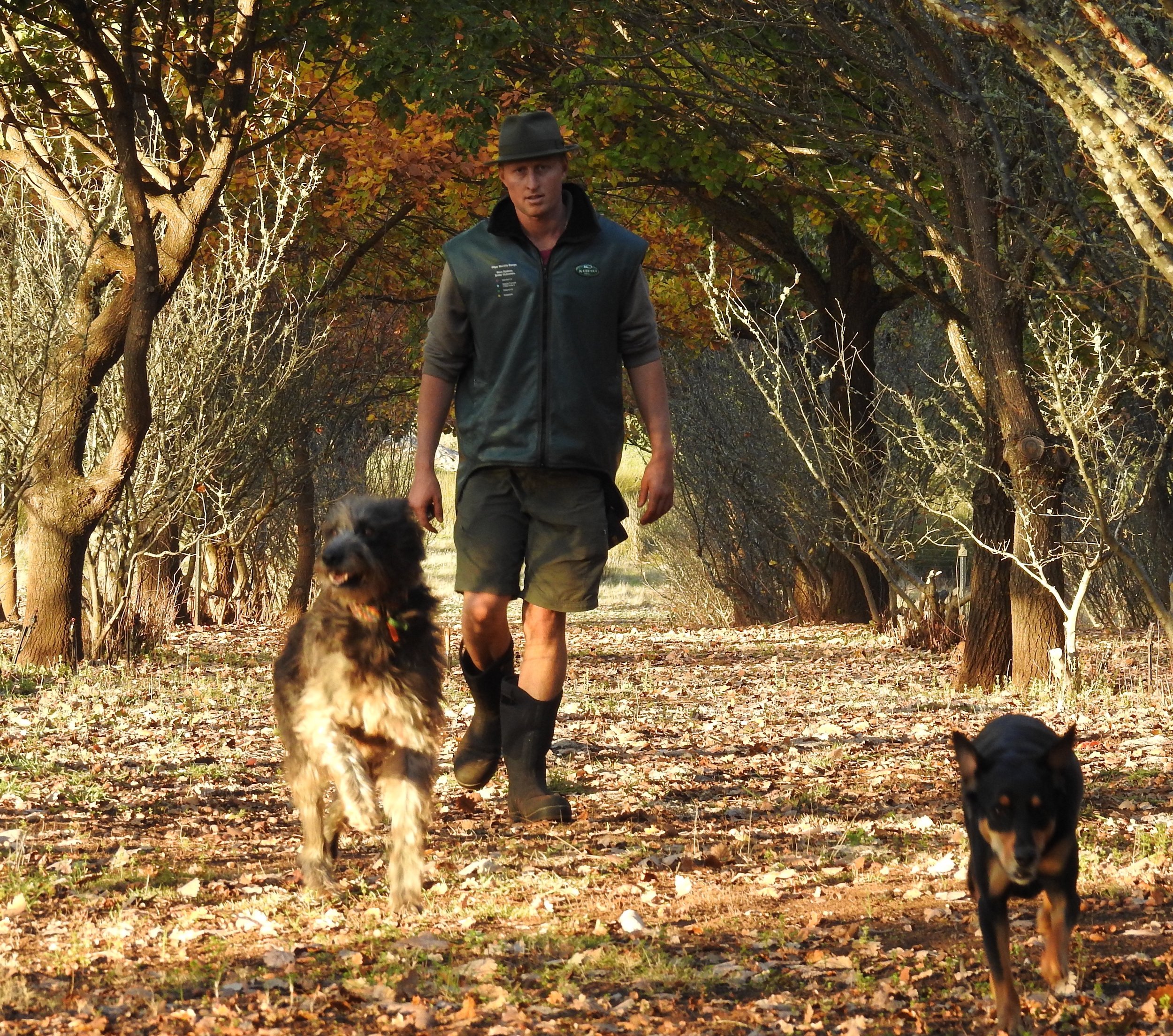Clear frosty winter mornings are what we look forward to as truffle hunters. They are much better than the alternative of storms! The dogs prefer them too- a windswept sleeting dawn has all but the bravest truffle dog heading back to a cosy bed by the fire!
Priority one is to let the dogs stretch their legs in the dawn light; while they do the obligatory perimeter check I can stoke the fire and boil the kettle.
Travel mug in hand, the ute has been packed the night before, and the dogs eagerly fly into their box. Keen noses blow steamy vapour through the mesh as the ute trundles out the driveway.
As the sun lights the eastern horizon you can see the clouds resting on the surrounding hills, and clear crisp air turns to foggy mist as the Cruiser climbs. Kangaroo appear and disappear as ghosts in the fog, and there is an occasional soundtrack provided by triple J as radio reception fades in and out.
The further inland we travel the more evident last night’s frost becomes, and as we disembark by the oak and hazelnut forest the dogs and I are greeted by smiling farmers; The dogs have the farmers well trained to give pats and affection on arrival- they seem to be quite strict about this.
As the dogs run around, warming up and busily investigating any new smells since last week, the farmers and I can discuss plans for the day, industry developments, and of course, the weather.
Once truffle orchards in Western Australia reach around ten years of age, they become very significant in the amount of the rich smelling fungus they produce each week. Most of the privately owned plantations are between 1000 and 2000 Oak and Hazelnut trees. As such it can take anywhere from 6-24 hours of experienced dog hunting time to ensure all ripe truffles are identified by the clever hounds. This hunt needs to be repeated every one to two weeks through the winter! Such sustained concentration can be very draining on the dogs from a psychological point of view. As such it is important a dog handler observes their body language and behaviour, thus allowing the dogs to be rested before they are truly fatigued. To achieve this in most paddocks we aim to rotate dogs after every 100 truffles, or one hour of hunt time.
We try to approach a paddock in a logical manner, and ensure we leave no tree unsearched for this rare delicacy- With a retail value of around $2000/kg, even leaving 1kg undiscovered is very undesirable for the producer, and as such we always want our dogs to bring their A game.
“A game” is an apt description, because this process needs to be ‘a game’ for our canine friends, if they thought it was a job I’m sure my favourite Kelpie bitch would contact a workers union and start a legal battle. As it stands I’m sure she sees truffle hunting as a great adventure. Between the food rewards, the pats and cuddles rained down on her, and relaxing evenings on her deerskin by the fire, it certainly seems to be an idyllic life. Quite a change in fortune for a pretty little dog who was left in a cardboard box on a Perth highway as a 6 week old puppy!
My other fully trained truffle dog is a shaggy haired Collie Staghound cross, he is a lovely intelligent dog; an athlete and a brilliant truffle hunter, but outside of the truffle paddock life is very scary for him. While he suffers from separation anxiety, and a variety of phobias, we have a good understanding these days. This allows him to live a relaxed enjoyable life both in and out of the truffle paddock.
After a morning of marking truffles up and down the rows we are often treated to a bowl of soup by a fireplace. The dogs usually appreciate a break from all the concentrating, and will enjoy a few sprinting laps around a nearby clearing, I cannot claim the dog handlers take part in anything as energetic!
Most lunch breaks in truffle hunting seem to result in a wardrobe change, adding or removing layers as squalls of rain arrive or depart. This is often true for the dogs as well, who are generally happy to work in quite heavy rain if they have their favourite jacket on.
Mid winter in the south west of Western Australia means our daylight hours are limited. Many paddocks are in shadows by 4.30pm, and the lack of light at 5pm makes it almost impossible to identify the black fungus in the dark soil.
Occasionally a post hunt beverage is enjoyed, but many days finish with a 100km+ drive for dog handlers, and an evening of washing truffle under icy taps for farmers.
Truffle hunting is a strange thing, while it all sounds cold wet and miserable, it is addictive, challenging and thrilling. There is a real sense of achievement after a big day with your dogs, and the camaraderie in the paddock is great to be a part of.
Will Powell shaggydogtruffles@gmail.com with Charlie and Dash.

